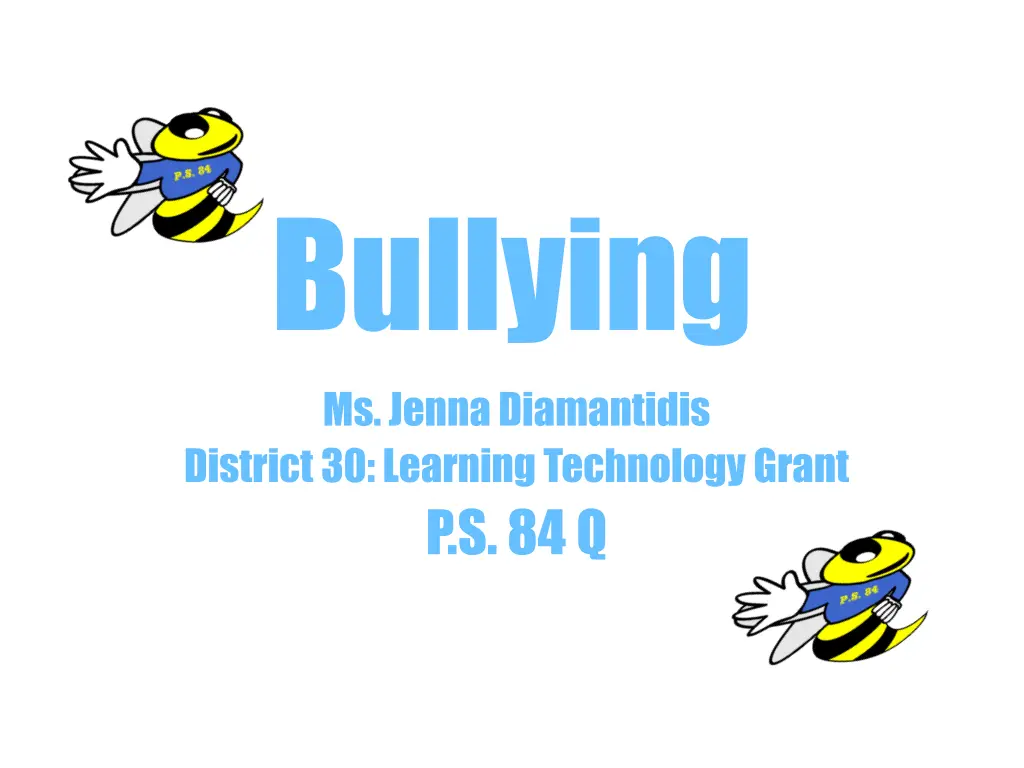
Preventing Bullying in School
Explore strategies to prevent bullying in school, including defining the problem, recognizing the difference between conflict and bullying, understanding the types of bullying, gathering evidence, and determining the causes. Help create a safe and inclusive school environment for all students.
Download Presentation

Please find below an Image/Link to download the presentation.
The content on the website is provided AS IS for your information and personal use only. It may not be sold, licensed, or shared on other websites without obtaining consent from the author. If you encounter any issues during the download, it is possible that the publisher has removed the file from their server.
You are allowed to download the files provided on this website for personal or commercial use, subject to the condition that they are used lawfully. All files are the property of their respective owners.
The content on the website is provided AS IS for your information and personal use only. It may not be sold, licensed, or shared on other websites without obtaining consent from the author.
E N D
Presentation Transcript
Bullying Ms. Jenna Diamantidis District 30: Learning Technology Grant P.S. 84 Q
Step 1: Define The Problem How can we prevent bullying in our school?
Turn & Talk How can you tell the difference between conflict and bullying? Bullying is not Bullying is
Conflict vs. Bullying -Disagreement or argument when both students express their views. -The student s goal is to hurt, harm or humiliate. -Power is not equal. One student has more power over another student -Equal power between all students involved. -The student will stop and their behavior will shift when they are aware and realize they ve hurt someone. -Student s behavior will continue even when they realize they ve hurt someone.
Types of Bullying 1. Verbal Bullying: Saying or writing mean things. 2. Physical Bullying: Hurting a person s body or damaging items that belong to them. 3. Social Bullying: Hurting someone s reputation or embarrassing them in person or through social media. 4. Cyber Bullying: Posting or sending negative, harmful, private or untrue information through social media.
Have you been bullied before? How did this make you feel?
Step 2: Gather Evidence The 2017 School Crime Supplement (National Center for Education Statistics and Bureau of Justice) indicates that, nationwide, about 20% of students ages 12-18 experienced bullying. The 2017 Youth Risk Behavior Surveillance System (Centers for Disease Control and Prevention) indicates that, nationwide, 19% of students in grades 9 12 report being bullied on school property in the 12 months preceding the survey.
Step 3: Determine the Causes Why do you think a student may act as a bully? Is the bully having a difficulty making friendships? Has the bully been bullied before? Are the incidents being reported? Turn & talk to a partner! Add any other causes you may think of!
Step 5: Develop Solutions Steinway SWAG Sanford Harmony Curriculum Core-Values Monthly Assembly #GoodNewsCallOfTheDay 1. 2. 3. 4.
I Pledge to -treat everyone with respect. -sprinkle a little bit of kindness each and every day. -encourage my friends to help and stand up to bullying instead of being a bystander. -include my peers, especially those who may be left out. -report verbal, physical, social or cyber bullying to a teacher or trusted adult. -never watch, laugh or join a group when someone is bullied. -do better because I know better!
Step 6: Selecting the Best Policy Model how to treat others with kindness and respect!
RESPECT FOR ALL WEEK! February 10th - February 14th! The NYC DOE has designated this week as R.F.A. We will continue to focus on promoting respect for diversity and creating inclusive school climates so that ALL students feel safe and respected! Bee the I in Kind!
